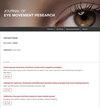眼模型参数变化对模拟眼动追踪结果的影响
IF 2.8
4区 心理学
Q3 OPHTHALMOLOGY
引用次数: 0
摘要
眼动追踪相关研究中使用的模拟数据主要是使用规范的眼模型生成的,很少考虑人群中眼生物特征的变化如何影响眼动追踪结果。本研究探讨了眼模型参数的变化对模拟数据预测现实世界眼动追踪结果的影响。两项相关比较研究的真实世界实验在模拟环境中使用高复杂性随机眼睛模型进行复制,该模型包括眼睛生物计量参数的解剖精确分布。结果表明,前角膜非球形度的变化显著影响插值和基于模型的注视估计算法的模拟眼动追踪结果。另外,更常见的变化参数,如角膜曲率半径和中央凹偏移角对模拟结果影响不大。本文章由计算机程序翻译,如有差异,请以英文原文为准。
The influence of eye model parameter variations on simulated eye-tracking outcomes
The simulated data used in eye-tracking-related research has been largely generated using normative eye models with little consideration of how the variations in eye biometry found in the population may influence eye-tracking outcomes. This study investigated the influence that variations in eye model parameters have on the ability of simulated data to predict real-world eye-tracking outcomes. The real-world experiments performed by two pertinent comparative studies were replicated in a simulated environment using a high-complexity stochastic eye model that includes anatomically accurate distributions of eye biometry parameters. The outcomes showed that variations in anterior corneal asphericity significantly influence simulated eye-tracking outcomes of both interpolation and model-based gaze estimation algorithms. Other, more commonly varied parameters such as the corneal radius of curvature and foveal offset angle had little influence on simulated outcomes.
求助全文
通过发布文献求助,成功后即可免费获取论文全文。
去求助
来源期刊

Journal of Eye Movement Research
OPHTHALMOLOGY-
CiteScore
2.90
自引率
33.30%
发文量
10
审稿时长
10 weeks
期刊介绍:
The Journal of Eye Movement Research is an open-access, peer-reviewed scientific periodical devoted to all aspects of oculomotor functioning including methodology of eye recording, neurophysiological and cognitive models, attention, reading, as well as applications in neurology, ergonomy, media research and other areas,
 求助内容:
求助内容: 应助结果提醒方式:
应助结果提醒方式:


